So far I have been able to translate everything in an ASP.Net Core 2.1 Web Application.
It has proven a little challenge, since the scaffolded Account Pages needed a little setup.
But what I cannot find is a way to translate the Password validation messages. Also, translating the model binding messages were a little challenge (thanks stackoverflow).
Any ideas?
I include the relevant parts of my Startup.cs file:
public void ConfigureServices(IServiceCollection services)
{
...
services.AddMvc(options =>
{
var type = typeof(SharedResources);
var assemblyName = new AssemblyName(type.GetTypeInfo().Assembly.FullName);
var factory = services.BuildServiceProvider().GetService<IStringLocalizerFactory>();
var L = factory.Create("SharedResources", assemblyName.Name);
options.ModelBindingMessageProvider.SetValueIsInvalidAccessor(x => L["The value '{0}' is invalid.", x]);
options.ModelBindingMessageProvider.SetValueMustNotBeNullAccessor(x => L["The value '{0}' is invalid.", x]);
options.ModelBindingMessageProvider.SetValueMustBeANumberAccessor(x => L["The field {0} must be a number.", x]);
options.ModelBindingMessageProvider.SetMissingBindRequiredValueAccessor(x => L["A value for the '{0}' property was not provided.", x]);
options.ModelBindingMessageProvider.SetAttemptedValueIsInvalidAccessor((x, y) => L["The value '{0}' is not valid for {1}.", x, y]);
options.ModelBindingMessageProvider.SetMissingKeyOrValueAccessor(() => L["A value is required."]);
options.ModelBindingMessageProvider.SetUnknownValueIsInvalidAccessor(x => L["The supplied value is invalid for {0}.", x]);
options.ModelBindingMessageProvider.SetMissingRequestBodyRequiredValueAccessor(() => L["A non-empty request body is required."]);
options.ModelBindingMessageProvider.SetNonPropertyAttemptedValueIsInvalidAccessor(x => L["The value '{0}' is not valid.", x]);
options.ModelBindingMessageProvider.SetNonPropertyUnknownValueIsInvalidAccessor(() => L["The supplied value is invalid."]);
options.ModelBindingMessageProvider.SetNonPropertyValueMustBeANumberAccessor(() => L["NonPropertyValueMustBeNumber"]);
})
.AddViewLocalization(LanguageViewLocationExpanderFormat.Suffix)
.AddDataAnnotationsLocalization(options =>
{
options.DataAnnotationLocalizerProvider = (type, factory) =>
{
// This is for Account scaffolded pages data annotations
return factory.Create(typeof(SharedResources));
};
});
...
}
I cannot put something like this in the InputModel of Register.cshtml.cs because the ErrorMessage gets ignored (and I won't do it anyways, since I don't want to hardcode the password policy description):
[Required(ErrorMessage = "The {0} field is required.")]
[StringLength(100, ErrorMessage = "The {0} must be at least {2} and at max {1} characters long.", MinimumLength = 6)]
[DataType(DataType.Password, ErrorMessage = "Password must be nice")]
[Display(Name = "Password")]
public string Password { get; set; }

